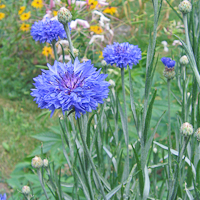| E-mail me at mcclainm@optonline.net | Visit my Facebook page | View my LinkedIn profile |
My Garden Plants
Michael L McClain
St James, NY
Bachelor Buttons
Centaurea cyanus

Cool weather annual that is easily grown in average, medium moisture, well-drained soils in full sun to light shade. Plant stems will droop in too much shade. Plants tolerate poor soils. Avoid wet soils. New plants may be grown each year by planting seed indoors 6-8 weeks before last spring frost date or outdoors at the last spring frost date. In mild winter climates, seed may be planted outdoors in fall. Plants may reseed in the garden. Deadheading spent flower heads will limit self-seeding, but in the process removes from the garden seeds that are loved by birds. Taller plants may need staking or other support.
Noteworthy Characteristics: Native to Europe, this annual cornflower has escaped gardens and naturalized throughout much of the United States and southern Canada. In Missouri, it is typically found in fields and waste grounds and along railroads and roadsides. Purple-blue flowers (sometimes pink to white) bloom from late spring into summer on 1- to 3-foot tall stems clad with lyrate-pinnatifid lower leaves and narrow lanceolate upper leaves. Each flower (to 1.5" diameter) is subtended an involucre of overlapping bracts. Flowers are attractive to butterflies.
Problems: No serious insect or disease problems. Wilt, rots and rusts may occur. Watch for aphids and mealybugs.
Uses: Beds, borders, cottage gardens, meadows and prairies. Cutting gardens.
I planted Bachelor buttons this spring and transplanted them to the garden outside the bathroom window. They came up nicely, though a bit disheveled. Today they are looking spent after two days of extremely hot weather.